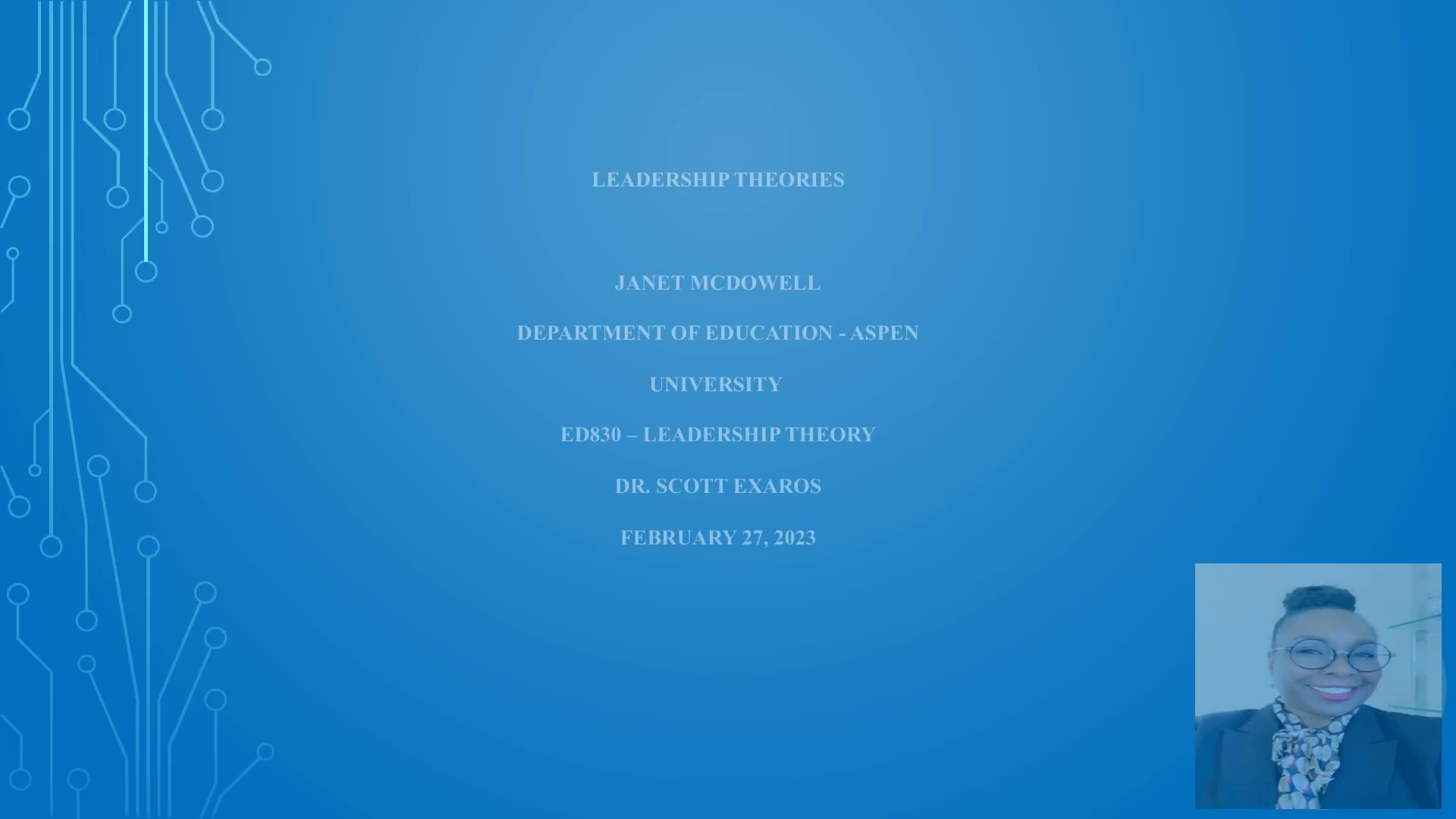Scene 1 (0s)
[Audio] LEADERSHIP THEORIES JANET MCDOWELL DEPARTMENT OF EDUCATION - ASPEN UNIVERSITY ED830 – LEADERSHIP THEORY DR. SCOTT EXAROS FEBRUARY 27, 2023.
Scene 2 (24s)
[Audio] LEADERSHIP THEORIES The purpose of this video is to discuss the following leadership theories and describe one that I can implement in my organization Contingency Leadership Theory Leadership Continuum Theory Path-Goal Leadership Theory Leadership Substitute Theory.
Scene 3 (49s)
[Audio] CONTINGENCY THEORY ( LUSSIER, 2015) • Attempts to find the best leadership style for all situations to maximize performance • 3rd major leadership paradigm ( 1960) • Leadership styles models are based on behavioral leadership theories • Also called situational leadership • Global contingency leadership – diverse workers • Fiedler developed first contingency leadership model leadership personality & behavior interacts with situational variables.
Scene 4 (1m 31s)
[Audio] CONTINGENCY LEADERSHIP MODEL F.E. Fielder; A Theory of Leadership Effectiveness ( New York; McGraw-Hill, 1967; F.E. Fiedler and M.M. Chemers, Improving Leadership Effectiveness; The Leader Math Concept, 2nd ed. (New York: Wiley, 1982)..
Scene 5 (2m 1s)
[Audio] CONTINUUM THEORY ( LUSSIER, 2015) • Robert Tannenbaum and Warren Schmidt – 1950's • Contingency Theory Framework on Decision Making • Continuum; boss centered to subordinate centered leadership • Boss, subordinates and situation forces • Autocratic to participative.
Scene 6 (2m 29s)
[Audio] CONTINUUM MODEL ( LUSSIER, 2015) State the decision that is not open to discussion Make the decision and convince employees that is a good idea Present the decision and ask if there are any questions Present a decision that is subject to change based on input State the situation, ask ofr a recommended decision, then makes the deision Let employees make a decision within set limits Let employees make ongoing decisons Autocratic Participative.
Scene 7 (3m 12s)
[Audio] PATH-GOAL LEADERSHIP THEORY ( LUSSIER, 2015) • Developed by Robert House; 1971 • Contingency Theory Framework • Select leadership style appropriate to situation, followers and environment • Leader determines followers' objectives and set goals to achieve them • Leadership styles to motivate followers and enhance performance • Directive • Supportive • Participative • Achievement-oriented.
Scene 8 (3m 53s)
[Audio] PATH-GOAL LEADERSHIP MODEL ( LUSSIER, 2015) Situation (Determine) Subordinate Authoritarianism Locus of Control Ability Environment Task structure Formal authority Work group Leadership Styles ( Affect) Directive Supportive Participative Achievement-oriented Goal Achievement Performance Satisfaction.
Scene 9 (4m 41s)
[Audio] LEADERSHIP SUBSTITUTES THEORY ( LUSSIER, 2015) • Steven Kerr and John Jermier • Contingency Theory Framework • Leadership styles are not necessary or redundant • Removing neutralizers for leaders • Increase substitutes; job enrichment, self-managing teams & automation.
Scene 10 (5m 10s)
[Audio] LEADERSHIP MODELS CRITICISMS ( LUSSIER, 2015) Contingency Leadership Theory Weak Statistical Results Validity & Usefulness of the model Change Leadership Style vs. Job context Leadership Continuum Theory Model is subjective; not clear on how or when to select a leadership style Path-Goal Leadership Theory Inclusive findings concerning moderator variables Which style to use and when is not determined Judgment calls can lead to adding unresearched variable to the model Leadership Substitute Theory Some aspects of the theory were not tested Peers and others act as leaders.
Scene 11 (6m 22s)
[Audio] PATH-GOAL LEADERSHIP THEORY IMPLEMENTATION • School Administrator • Path-Goal Leadership Theory • Rationale- limited beliefs especially in diverse settings on school with a large underserved population • Educators' mindset based on their experiences and track record • Coaching & Mentorship is important • Data driven focus to monitor progress for effectiveness, goal setting based on evaluations to create procedures and protocols that will yield the desired results • Celebrating progress and accomplished goals; to motivate continued success.
Scene 12 (7m 7s)
[Audio] PATH-GOAL THEORY IMPLEMENTATION The Data-Driven Model ( Santoyo, ( 2012): Assessment: Define the roadmap for rigor. Analysis: Determine where students are struggling and why. Action: Implement new teaching plans to respond to this analysis. Systems: Create systems and procedures to ensure continual data-driven decision-making improvements Author Couros, ( 2015) states, "Great leaders practice balancing trust and autonomy while providing strong mentorship.".
Scene 13 (7m 52s)
[Audio] References Bambrick-santoyo, P. ( 2012). Leverage Leadership ( 1st ed.) [ Review of Leverage Leadership]. Jossey-Bass. Couros, G. ( 2015). The innovator's mindset: Empower learning, unleash talent, and lead a culture of creativity. Dave Burgess Consulting, Inc. F.E. Fielder; A Theory of Leadership Effectiveness ( New York; McGraw-Hill, 1967; F.E. Fiedler and M.M. Chemers, Improving Leadership Effectiveness; The Leader Math Concept, 2nd ed. (New York: Wiley, 1982). Lussier, R. N. & Achua, C. F. ( 2016). Leadership: Theory, Application, & Skill Development. Cengage Learning..
